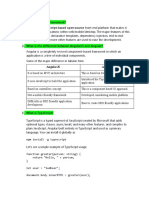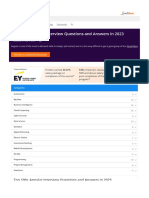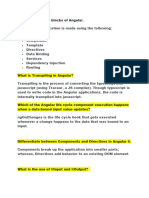Angular Interview Questions
Uploaded by
Ashok KumarAngular Interview Questions
Uploaded by
Ashok KumarAngular Interview Questions & Answers
1. What is Angular and its main principles?
Angular is an open-source, TypeScript-based framework developed by Google for
building single-page applications (SPAs). It provides a structured approach to web
development.
Main Principles of Angular:
Component-based architecture
Data binding
Dependency Injection (DI)
Directives
Routing
Services and Observables
Modular structure
2. What is TypeScript in Angular?
TypeScript is a statically typed superset of JavaScript that enhances JavaScript’s
capabilities, making it easier to maintain large-scale applications. It is the preferred
language for Angular development.
3. What is a Component in Angular?
A component is a fundamental building block of an Angular application. It consists of:
Class (TypeScript file) – Defines business logic
Template (HTML file) – Defines the view
Styles (CSS or SCSS file) – Defines the component-specific styles
@Component decorator – Provides metadata for Angular
4. What are Single Page Applications (SPAs) and their key characteristics?
A Single Page Application (SPA) dynamically updates the view without reloading the
entire page.
Key Characteristics:
Dynamic Content Loading
Smooth User Experience
Client-Side Routing
Rich User Interfaces
Data Binding
Asynchronous Data Handling
5. What is Data Binding? Explain its types.
Data binding establishes communication between the model (data) and the view (UI).
Types of Data Binding:
Interpolation (One-Way Binding): {{ expression }}
Property Binding (One-Way Binding): [property]="expression"
Event Binding (One-Way Binding): (event)="expression"
Two-Way Binding: [(ngModel)]="expression"
6. What are Decorators in Angular?
Decorators provide metadata and modify the behavior of Angular components, services,
and directives.
Common Decorators:
@NgModule – Defines an Angular module
@Component – Defines an Angular component
@Directive – Creates custom directives
@Injectable – Defines a service for DI
@Input – Passes data from parent to child component
@Output – Sends data from child to parent component
7. What are Directives in Angular and their types?
Directives modify the behavior of HTML elements.
Types of Directives:
Component Directives – Components with a template
Structural Directives – Modify the DOM structure (*ngIf, *ngFor)
Attribute Directives – Modify element appearance (ngClass, ngStyle)
8. What are Pipes in Angular?
Pipes are used to transform data in templates.
Built-in Pipes:
DatePipe – Formats dates
UpperCasePipe, LowerCasePipe – Changes text case
CurrencyPipe, DecimalPipe, PercentPipe – Formats numbers
9. What is String Interpolation in Angular?
String interpolation allows embedding expressions inside HTML templates using {{ }}
syntax.
10. What are Pure and Impure Pipes?
Pure Pipes – Returns the same output for the same input (default behavior).
Impure Pipes – Can produce different outputs for the same input due to
external factors.
11. Explain Lifecycle Hooks in Angular.
Lifecycle hooks allow developers to execute logic at different phases of a component's
lifecycle.
Common Lifecycle Hooks:
ngOnChanges() – Executes when input properties change
ngOnInit() – Executes after component initialization
ngDoCheck() – Executes during every change detection cycle
ngAfterContentInit() – Executes after content is projected
ngAfterViewInit() – Executes after view initialization
ngOnDestroy() – Executes before component destruction
12. How do components communicate in Angular?
Methods for Data Sharing:
@Input() – Parent to child component
@Output() with EventEmitter – Child to parent component
Service-based Communication – Shared service for data transfer
13. What are Event Emitters in Angular?
EventEmitter allows components to emit custom events that parent components can
listen to.
14. What is View Encapsulation in Angular?
View encapsulation ensures that styles defined for one component do not affect others.
15. What is Routing in Angular?
Routing enables navigation between different views in an SPA.
Key Routing Features:
RouterModule – Configures routing
RouterOutlet – Defines where components are rendered
RouterLink – Provides navigation links
Route Guards – Secures routes
16. What are Templates in Angular?
A template defines the structure of a component’s view using HTML and Angular-
specific syntax.
17. What is an Angular Module?
A module organizes components, directives, and services into cohesive units. The root
module is AppModule.
18. What is the @NgModule decorator?
The @NgModule decorator configures an Angular module by defining components,
directives, pipes, and providers.
19. Advantages of AOT Compilation
Faster initial load time
Smaller bundle size
Improved security
Early error detection
20. Difference Between AOT and JIT
Feature AOT (Ahead-of-Time) JIT (Just-in-Time)
Compilation Time Before runtime At runtime
Performance Faster Slower
Use Case Production Development
21. What are Promises and Observables?
Promises – Handles a single asynchronous event.
Observables – Handles multiple asynchronous events over time (RxJS).
22. What is FormsModule in Angular?
The FormsModule enables two-way data binding for template-driven forms.
23. What is ReactiveFormsModule in Angular?
The ReactiveFormsModule allows building reactive forms using FormControl,
FormGroup, and FormArray.
24. What is the PipeTransform Interface?
The PipeTransform interface is used to create custom pipes by implementing the
transform method.
25. What are Services in Angular?
A service is an injectable class that provides reusable logic across components. Created
using:
ng generate service my-service-name
26. What is ngOnInit?
ngOnInit() is a lifecycle hook that runs after component initialization.
27. What is Eager and Lazy Loading?
Eager Loading – Loads all modules upfront.
Lazy Loading – Loads modules on demand, improving performance.
28. How does an Angular Application Work?
1. Bootstrapping – main.ts initializes AppModule.
2. Modules – Organize the application.
3. Components – Define the UI.
4. Templates & Binding – Manage views.
5. Services & DI – Handle business logic.
6. Routing – Controls navigation.
7. Change Detection – Updates the DOM.
29. What is MVVM Architecture?
MVVM (Model-View-ViewModel) separates logic from the UI, improving maintainability.
30. What is RxJS in Angular?
RxJS is a library for reactive programming using Observables.
31. What are Router Links?
RouterLink allows navigation between different views without reloading the page.
32. What are HTTP Interceptors?
HTTP interceptors modify requests and responses globally, commonly used for
authentication and logging.
You might also like
- Latest Angular Interview Questions and Answers-1100% (1)Latest Angular Interview Questions and Answers-126 pages
- Angular Interview Questions and AnswersNo ratings yetAngular Interview Questions and Answers17 pages
- Latest Angular Interview Questions and AnswersNo ratings yetLatest Angular Interview Questions and Answers28 pages
- Top 30 Interview Questions and Answers On Angular 5: Introduction To Web TechnologyNo ratings yetTop 30 Interview Questions and Answers On Angular 5: Introduction To Web Technology7 pages
- Angular Interview Questions With AnswersNo ratings yetAngular Interview Questions With Answers6 pages
- Angular Interview Questions and AnswersNo ratings yetAngular Interview Questions and Answers39 pages
- Top 100+ Angular Interview Questions & Answers in 2023 - IntellipaatNo ratings yetTop 100+ Angular Interview Questions & Answers in 2023 - Intellipaat25 pages
- Top Angular Interview Questions You Must Prepare For 2020 - EdurekaNo ratings yetTop Angular Interview Questions You Must Prepare For 2020 - Edureka9 pages
- angularinterviewquestionpdfbyscholarhat-240717110413-292b6154No ratings yetangularinterviewquestionpdfbyscholarhat-240717110413-292b615436 pages
- 60+ Angular Interview Questions in 2024 - Prepare Like A ProNo ratings yet60+ Angular Interview Questions in 2024 - Prepare Like A Pro37 pages
- GitHub - Sudheerj-Angular-Interview-questions- List of 300 Angular Interview Questions and AnswersNo ratings yetGitHub - Sudheerj-Angular-Interview-questions- List of 300 Angular Interview Questions and Answers159 pages
- CS QP - CLASS XI ANNUAL EXAM APRIL 30TH (1)No ratings yetCS QP - CLASS XI ANNUAL EXAM APRIL 30TH (1)5 pages
- Duplex Tank Mounted Lubricated Rotary Vane Medical Vacuum Systems 7.5 AND 10 HPNo ratings yetDuplex Tank Mounted Lubricated Rotary Vane Medical Vacuum Systems 7.5 AND 10 HP2 pages
- Assignment of Group Case Study 1: Submitted by0% (1)Assignment of Group Case Study 1: Submitted by3 pages
- 2020 Hitachi Electric Chain Hoist - Product SheetNo ratings yet2020 Hitachi Electric Chain Hoist - Product Sheet5 pages
- MPC Instrument Collection Installation GuideNo ratings yetMPC Instrument Collection Installation Guide23 pages
- Determination of Elements by Graphite Furnace Atomic Absorption SpectrometryNo ratings yetDetermination of Elements by Graphite Furnace Atomic Absorption Spectrometry9 pages
- Parental Consent For Your Child To Participate in A Research Study 1No ratings yetParental Consent For Your Child To Participate in A Research Study 14 pages
- Footprinting - Putri Erawaty Bakara - N.Priskila Napitupulu - Yanada Sari BR SitumorangNo ratings yetFootprinting - Putri Erawaty Bakara - N.Priskila Napitupulu - Yanada Sari BR Situmorang50 pages
- RICE - Information Sheet and Data Privacy Consent FormNo ratings yetRICE - Information Sheet and Data Privacy Consent Form1 page
- Lecture No.45 Data Structures: Dr. Sohail AslamNo ratings yetLecture No.45 Data Structures: Dr. Sohail Aslam54 pages
- Awesome Charts Documentation: Table of ContentNo ratings yetAwesome Charts Documentation: Table of Content22 pages
- System Approaches To Water, Sanitation, and Hygiene A Systematic Literature ReviewNo ratings yetSystem Approaches To Water, Sanitation, and Hygiene A Systematic Literature Review18 pages
- Top 30 Interview Questions and Answers On Angular 5: Introduction To Web TechnologyTop 30 Interview Questions and Answers On Angular 5: Introduction To Web Technology
- Top 100+ Angular Interview Questions & Answers in 2023 - IntellipaatTop 100+ Angular Interview Questions & Answers in 2023 - Intellipaat
- Top Angular Interview Questions You Must Prepare For 2020 - EdurekaTop Angular Interview Questions You Must Prepare For 2020 - Edureka
- angularinterviewquestionpdfbyscholarhat-240717110413-292b6154angularinterviewquestionpdfbyscholarhat-240717110413-292b6154
- 60+ Angular Interview Questions in 2024 - Prepare Like A Pro60+ Angular Interview Questions in 2024 - Prepare Like A Pro
- GitHub - Sudheerj-Angular-Interview-questions- List of 300 Angular Interview Questions and AnswersGitHub - Sudheerj-Angular-Interview-questions- List of 300 Angular Interview Questions and Answers
- Duplex Tank Mounted Lubricated Rotary Vane Medical Vacuum Systems 7.5 AND 10 HPDuplex Tank Mounted Lubricated Rotary Vane Medical Vacuum Systems 7.5 AND 10 HP
- Determination of Elements by Graphite Furnace Atomic Absorption SpectrometryDetermination of Elements by Graphite Furnace Atomic Absorption Spectrometry
- Parental Consent For Your Child To Participate in A Research Study 1Parental Consent For Your Child To Participate in A Research Study 1
- Footprinting - Putri Erawaty Bakara - N.Priskila Napitupulu - Yanada Sari BR SitumorangFootprinting - Putri Erawaty Bakara - N.Priskila Napitupulu - Yanada Sari BR Situmorang
- RICE - Information Sheet and Data Privacy Consent FormRICE - Information Sheet and Data Privacy Consent Form
- System Approaches To Water, Sanitation, and Hygiene A Systematic Literature ReviewSystem Approaches To Water, Sanitation, and Hygiene A Systematic Literature Review






























































































